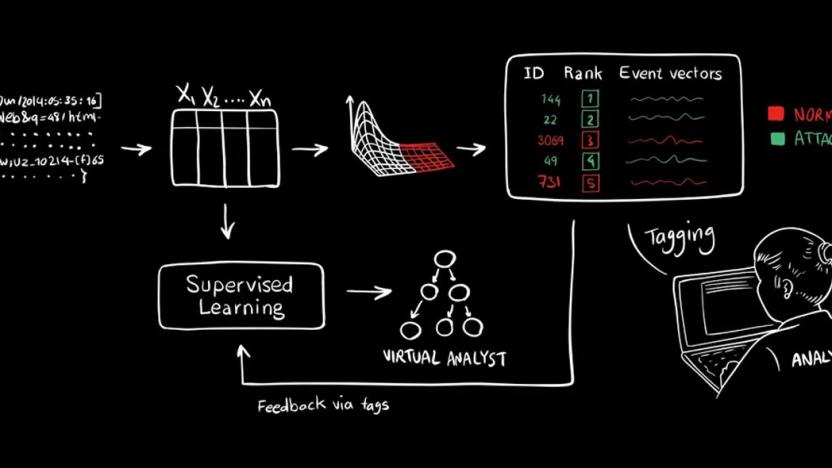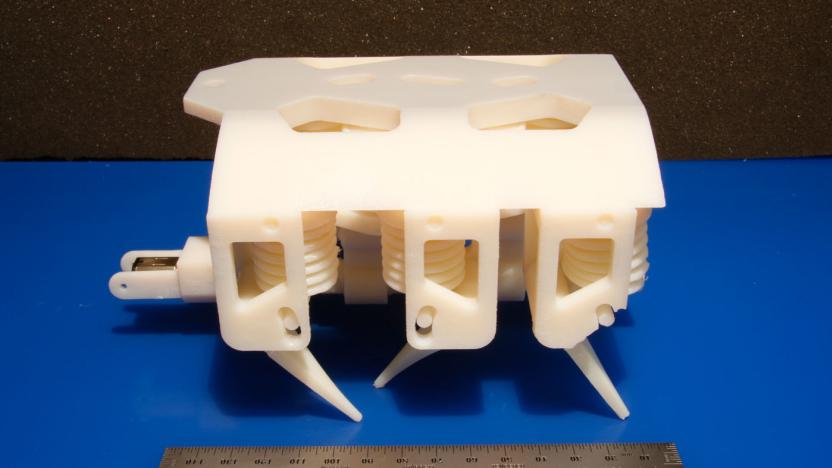csail
Latest

MIT's digital lookout in the crows nest of cyber warfare
"Think about the system as a virtual analyst," says Kaylan Veermachaneni, co-creator of MIT's latest artificial intelligence. He's a research scientist at the university's Computer Science and Artificial Intelligence lab that, along with Ignacio Arnaldo, built an AI that acts as a lookout for the age of cyber warfare. AI2 (Short for Artificial Intelligence Squared) is a system designed to spot a hacking attack better than humans and existing software. They claim that the program can detect 85 percent of malicious attacks, although that figure is set to rise the more it learns. We can already imagine Sony's IT gurus beating a path to Massachusetts with a suitcase stuffed full of unmarked bills.

MIT 3D prints a complete walking robot
A team from MIT's Computer Science and Artificial Intelligence Lab believe that it's created a new way to 3D print whole robots. The breakthrough that researchers have made centers around creating what's being called "printable hydraulics," a way to create liquid-filled pumps inside the manufacturing process. According to CSAIL director Daniella Rus, the technique "is a step towards the rapid fabrication of functional machines." She adds that "all you have to do is stick in a battery and motor and you have a robot that can practically walk right out of the printer."

WiFi distance detector could shut out router invaders
Researchers from MIT have figured out how to detect the distance between WiFi users and a single router, a feat that could make drones safer and public internet more secure. They did it by measuring the "time of flight" of WiFi signals between the transmitter and receiver, and multiplying by the speed of light to calculate distance. That concept isn't new, but MIT's CSAIL team, which has already looked through walls using WiFi, managed to build a working prototype.

MIT has a way to speed up web browsing by 34 percent
Sure, Google has a way to reduce page load speeds, but that's limited to mobile for now. From the sounds of it, the venerable Massachusetts Institute of Technology has other plans that could make mobile and desktop web browsing about 34 percent faster. Instead of using compression, MIT's Computer Science and Artificial Intelligence Lab (CSAIL), along with Harvard, have developed a framework that changes how a browser downloads things like images and JavaScript.

Watch a smart drone fly through a 'forest' all on its own
Drones can already find their way around obstacles, but they're usually looking for obvious obstacles like walls. What about navigating through tiny spaces where there may be just inches to spare? MIT has the answer. It just demonstrated tiny quadcopter drones using cutting-edge algorithms (the same ones used in the walking Atlas robot) to wend their way through a "forest" of 26 closely-packed obstacles. The trick is to flip the usual pathfinding routine on its head -- rather than plan a course based on the obstacles, the algorithms look for free spaces and string them together to create a safe route. As the video below shows, the result is a drone that zips effortlessly around poles and wires.

An algorithm can tell if your face is forgettable
Some faces are more memorable than others. The brain processes visual cues to decide if a face or an image will stay lodged in the memory bank. What if a network could be trained to imitate that response? You could potentially alter the visuals for a greater impact. A team of researchers at MIT's Computer Science and Artificial Intelligence Laboratory (CSAIL) has built MemNet, a deep learning based algorithm that predicts the "memorability" of your photographs almost as well as the human brain.

Researchers hide messages in a sea of spam
Researchers are trying quantum cryptography and other exotic ways to keep your missives safe, but here's a new one: junk mail. A team of computer scientists from MIT's CSAIL have devised a system called "Vuvuzela" that adds noise to messages, making them virtually untraceable to the recipient or sender. While it uses nodes like the Tor "dark internet" router, it only requires a few servers and relies more on numerous fake messages to confuse hackers. If scaled up, the technique could give you nearly mathematical certainty that your messages and even metadata are secure.

Many of your Android apps send unnecessary hidden data
It won't shock you to hear that Android apps send a lot of data, but you may be surprised at how much of it isn't really necessary... or public, for that matter. MIT researchers have determined that "much" of the hidden data sent and received by the 500 most popular Android apps isn't necessary to the functionality. For example, a Walmart app talks to eBay whenever you scan a barcode -- there's no practical difference when you sever that connection. Out of the 47 apps that MIT modified to prove its case, 30 were virtually indistinguishable from the official versions. The rest only had minor issues, like missing ads.

NASA sends its Valkyrie humanoid robots to college
NASA wants to send its 6-foot-tall, 290-pound humanoid robot R5 (which also goes by the more intimidating name "Valkyrie") to Mars and other extraterrestrial locations. The agency originally designed the R5 for search-and-rescue missions, though, so to prepare the machine for a future of exploration in harsh environments, it's sending two units to college. One will go to MIT, specifically to the Computer Science and Artificial Intelligence Laboratory (CSAIL), and the other to Northeastern University in Boston. The institutions were chosen from among the groups that joined DARPA's Robotics Challenge, and each will receive $250,000 per year for two years to finance their research.

ICYMI: Obstacle-avoiding UAV, smartwatch whys and more
#fivemin-widget-blogsmith-image-421365{display:none;} .cke_show_borders #fivemin-widget-blogsmith-image-421365, #postcontentcontainer #fivemin-widget-blogsmith-image-421365{width:570px;display:block;} try{document.getElementById("fivemin-widget-blogsmith-image-421365").style.display="none";}catch(e){}Today on In Case You Missed It: A new wearable screen that runs Android while strapped to your wrist is out, but we can't help but make fun of it. MIT's Computer Science and Artificial Intelligence Lab created a UAV that can fly through a forest safely with an obstacle avoidance algorithm. And a prototype gun for objects lets users whip together large-scaled 3D designs using run-of-the-mill packing tape.

Autonomous drone can avoid obstacles even in unfamiliar environments
Andrew Barry, a PhD student at MIT's Computer Science and Artificial Intelligence Lab (CSAIL), has developed a detection algorithm that allows UAVs to avoid objects on their own. Even better, it works even if the planes don't have existing knowledge/data about a particular location. Barry believes an algorithm faster than existing ones is necessary for truly autonomous drones. LIDAR laser systems, he said, are typically too heavy for small, personal UAVs, while current algorithms are too slow to match their speed.

Digital pens help spot early signs of brain conditions
Doctors frequently check for early signs of brain conditions like Alzheimer's and Parkinson's by looking at irregularities in your drawings, but it's an imperfect art based largely on the doctor's opinion. All too often, the only concrete signs show up by the time you've already been ravaged by the disease. MIT researchers might have a more effective way to catch these conditions early on, though. By using custom tracking software to monitor the output from a digital pen, they can more accurately predict the onset of brain conditions based not only on what you draw, but how you draw. Healthy people spend a bit more time thinking than scribbling; those with memory issues (such as Alzheimer's sufferers) spend a lot more time in thought, while Parkinson's patients tend to struggle with the drawing process.

Computers are learning to size up neighborhoods using photos
Us humans are normally good at making quick judgments about neighborhoods. We can figure out whether we're safe, or if we're likely to find a certain store. Computers haven't had such an easy time of it, but that's changing now that MIT researchers have created a deep learning algorithm that sizes up neighborhoods roughly as well as humans. The code correlates what it sees in millions of Google Street View images with crime rates and points of interest; it can tell what a sketchy part of town looks like, or what you're likely to see near a McDonald's (taxis and police vans, apparently).

MIT's soft robotic tentacle can squeeze into tight spots (video)
MIT's Computer Science and Artificial Lab (CSAIL) has been developing different types of soft robots for a while: you might remember the mechanical fish from earlier this year that can swim like a real one. Now, that same laboratory has come up with another soft robot, and this time it's inspired by a wriggly, slithery octopus tentacle. CSAIL's robotic "arm" is made entirely out of silicone using 3D-printed molds -- even the "motors" that propel it forward are merely hollow expandable silicone divided into sections. Air is then pumped into the appropriate sections in order for the tentacle to bend, slither and squeeze through.

Laser-toting MAV can find its way in tight spaces, might eventually hunt you down (video)
A perpetual weakness of MAVs (micro air vehicles) is their frequent need for hand-holding in anything other than a wide-open or very controlled space. If they're not using GPS or motion sensors to find their locations, they can't turn on a dime the way a human pilot would. Adam Bry, Abraham Bachrash and Nicholas Roy from MIT's CSAIL group haven't overcome every problem just yet, but they may have taken combat drones and other pilotless aircraft a big step forward by giving them the tools needed to fly quickly when positioning isn't an option. Uniting a laser rangefinder with an existing 3D map of the environment -- still 'cheating,' but less dependent -- lets the prototype flyer find the distance to nearby obstacles and steer clear even at speeds that would scare any mere mortal MAV. Ideally, future designs that can create their own maps will be completely independent of humans, making us think that MIT's references to "aggressive" autonomous flight are really cues to start hiding under the bed.

Inefficient? MIT's new chip software doesn't know the meaning of the word
Would you rather have a power-hungry cellphone that could software-decode hundreds of video codecs, or a hyper-efficient system-on-chip that only processes H.264? These are the tough decisions mobile designers have to make, but perhaps not for much longer. MIT's Computer Science and Artificial Intelligence Laboratory has developed a solution that could spell the end for inefficient devices. Myron King and Nirav Dave have expanded Arvind's BlueSpec software so engineers can tell it what outcomes they need and it'll decide on the most efficient design -- printing out hardware schematics in Verilog and software in C++. If this outcome-oriented system becomes widely adopted, we may never need worry about daily recharging again: good because we'll need that extra power to juice our sporty EV. [Image courtesy of MIT / Melanie Gonick]

MIT dreams of fully autonomous greenhouse, will definitely make it happen
You know what's hard to find these days? Consistency and reliability -- in anything, really. But we've learned that when MIT touches something, it not only gets done, but it gets done right. Thus, we're absolutely elated to hear that a few of its students have dreamed up a fully autonomous greenhouse, utilizing real plants, sensors and gardening robots to ensure the greenest, most healthy crop possible. In fairness, we've already seen oodles of robotic plant tending apparatuses, but this is just something special. Thus far, gurus have used "re-imagined versions of iRobot's Roomba" in order to tell what a plant needs and then respond accordingly, and apparently, things have been going quite well early on. Check out a demonstration vid just past the break.[Via MAKE]







